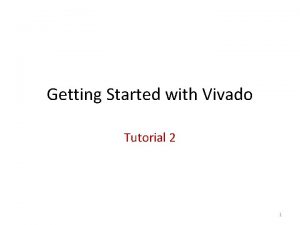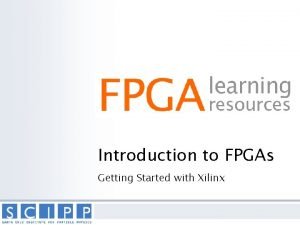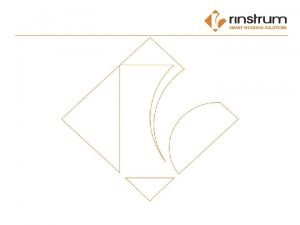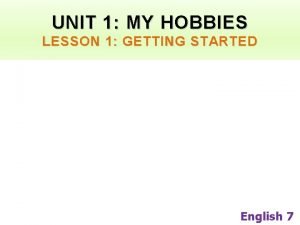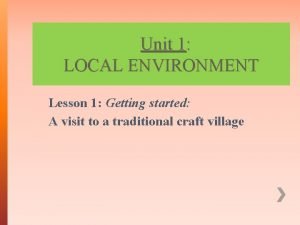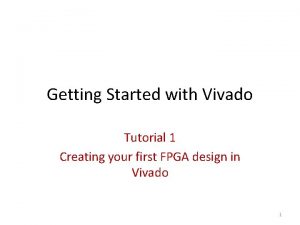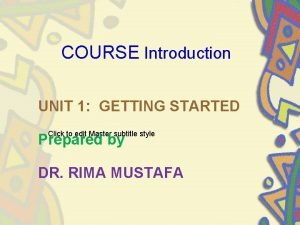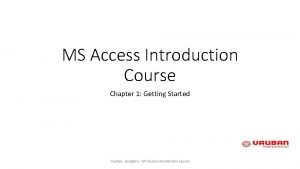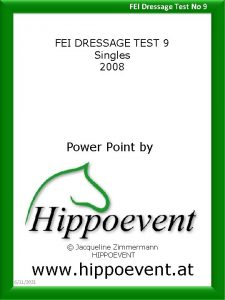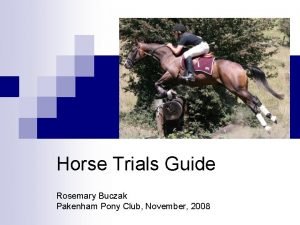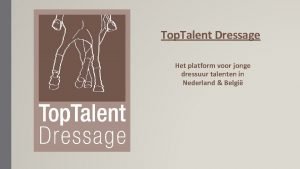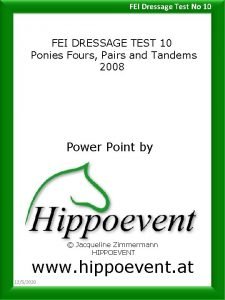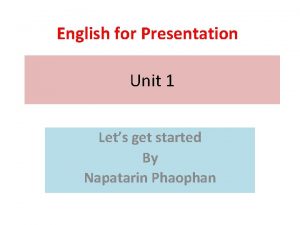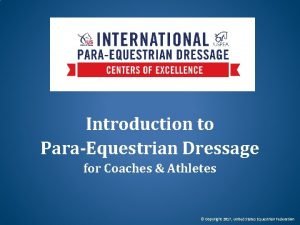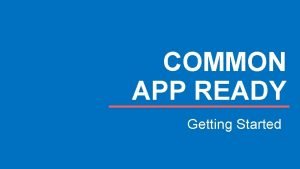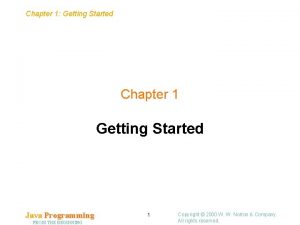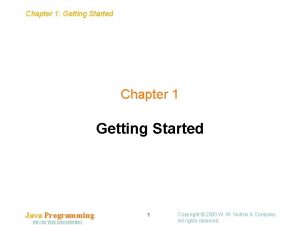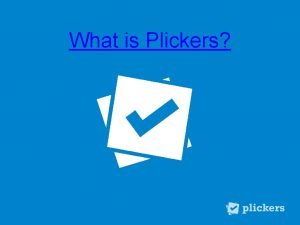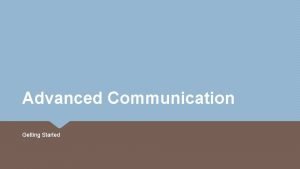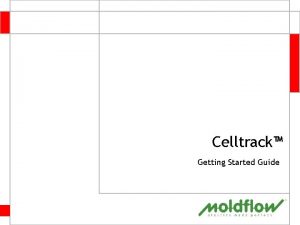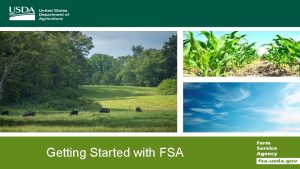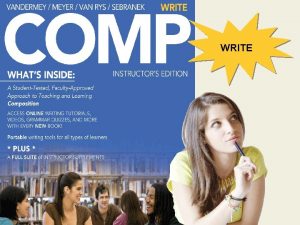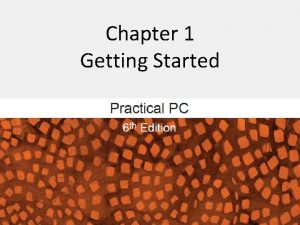INTRODUCTION TO PARAEQUESTRIAN DRESSAGE Getting Started PRESENTATION MADE
































- Slides: 32

INTRODUCTION TO PARA-EQUESTRIAN DRESSAGE Getting Started

PRESENTATION MADE POSSIBLE BY BY NORTH TEXAS EQUESTRIAN CENTER AND TEXAS THERAPEUTIC RIDING CENTER SUPPORTED BY THE UNITED STATES EQUESTRIAN FEDERATION AND THE UNITED STATES PARA EQUESTRIAN ASSOCIATION

WHAT IS PARA-EQUESTRIAN DRESSAGE? • Para-Equestrian Dressage is similar to Equestrian Dressage, but athletes are divided into 5 different competition grades based on their functional abilities. • Para Dressage is a sport governed by the Federation Equestre Internationale (FEI), and the only equestrian discipline included in the Paralympic Games. • Paralympic Games are an international competition, including para-dressage, regulated by the International Paralympic Committee (IPC), for athletes with permanent physical impairments. It occurs every 4 years.

WHAT IS EQUESTRIAN DRESSAGE? • Dressage is one of three equestrian Olympic disciplines, and showcases all levels of training of the horse and rider team in a competitive format. • “Dressage” refers to training of the horse, and has been in existence since ancient Greece. • Dressage has been an Olympic sport since the inception of the modern Olympics in 1896.

PARA DRESSAGE ARENAS Arena dimension: Grades I, II and III 20 X 40 meters Grades IV and V 20 X 60 meters Arena letters placed according to arena size.

DRESSAGE ARENA - SMALL

DRESSAGE ARENA - LARGE

FIRST STEPS FOR INSTRUCTORS 1. Attend Coaching Seminars 2. Join USEF 3. Begin USEF Para-Equestrian Coaches certification process www. usef. org

IDENTIFY YOUR RIDERS • Which clients are eligible for Para Dressage? • Current skill level • Identify goals of rider—i. e. competition vs. recreation

PARA DRESSAGE TESTS • • Grade I tests: athletes compete at walk. Grade II tests: athletes compete at mostly walk, some trot. Grade III tests: athletes compete at some walk, mostly trot. Grade IV tests: athletes compete at walk, trot with lateral work, and canter. • Grade V tests: athletes compete at walk, trot and canter with lateral work, and collected and extended gaits

PARA DRESSAGE ATHLETE CLASSIFICATION • Eligibility - It is a condition of participation that the Athlete has a permanent, verifiable and measurable physical or visual impairment which is supported by medical evidence and satisfies the minimal impairment criteria as detailed in the FEI PE Classification Manual. • Age – 14 years or older for National/International competition, 16 years or older for Major Championships except NAJYRC. • Memberships: Member in good standing with USEF for National Competition, and FEI for International.

PARA DRESSAGE ATHLETE CLASSIFICATION • Grade System is Grade I – Grade 5, with Grade 1 most severely impaired and Grade 5 least impaired

PARA DRESSAGE GRADES Grade I Para Dressage Mainly wheelchair users with impairment of all 4 limbs, may be able to walk with an unsteady gait, however trunk and balance are severely impaired

PARA DRESSAGE GRADES Grade II Para Dressage Mainly wheelchair users with poor trunk balance and or impairment of function in all four limbs, or no trunk balance and good upper limb function, or moderate trunk balance with severe Impairment of all 4 limbs.

PARA DRESSAGE GRADES Grade III Para Dressage Mainly wheelchair users or those with severe movement and mobility Impairment involving the trunk and with good to mild upper limb function, those with severe arm Impairment and slight leg Impairment or severe unilateral Impairment.

PARA DRESSAGE GRADES Grade IV Dressage Usually able to walk without support. Moderate unilateral Impairment or moderate Impairment in four limbs or severe arm Impairment. Athlete may need a wheelchair for longer distances or due to lack of stamina. Total loss of sight in both eyes. Blacked out glasses or blind fold must be worn by Profile 36 Athletes.

PARA DRESSAGE GRADES Grade V Para Dressage Impairment in one or two limbs or some visual Impairment. Ineligible < 15% in one limb or trunk, B 3 -4 visual, hearing impairment, intellectual impairment, health condition difficult to measure or grade

ELIGIBLE FOR PARA DRESSAGE GRADES MUST BE PERMANENT, VERIFIABLE AND MEASURABLE; MAY INCLUDE: Movement and mobility Neurological –hypertonia (spasticity, rigidity, dystonia); ataxia; peripheral nerve damage; impaired muscle power Examples of presenting health conditions may include: • Cerebral palsy • Stroke • Traumatic brain injury • Multiple sclerosis

ELIGIBLE FOR PARA DRESSAGE GRADES MUST BE PERMANENT, VERIFIABLE AND MEASURABLE; MAY INCLUDE: Congenital limb deficiency; amputations; impaired passive range of movement; impaired muscle power; leg length difference; short stature. Examples of presenting health conditions may include: • Arthrogryposis • Spinal cord injury (SCI) –complete or incomplete • Muscular dystrophy • Spina bifida Visual Impairment (B 1 or B 2). Refer to IBSA Classification Rules

NOT ELIGIBLE FOR PARA DRESSAGE GRADES NOT PERMANENT, VERIFIABLE OR MEASURABLE; MAY INCLUDE: General debilitating disease Obesity Osteochondritis Impairments of mental functions (including intellectual Impairment or retardation; conversion disorder; dementia; learning impairments) Hypermobility of joints Low muscle tone or hypotonia Sleep related movement disorders

NOT ELIGIBLE FOR PARA DRESSAGE GRADES NOT PERMANENT, VERIFIABLE OR MEASURABLE; MAY INCLUDE: Epilepsy Fatigue as in fibromyalgia and myalgic encephalitis Hearing impairment Vertigo or dizziness Cardiac/circulatory conditions Respiratory conditions Internal organ dysfunction or absence Generalized Pain Reflex Sympathetic Dystrophy without permanent joint impairment, muscle wasting.

PARA DRESSAGE COMPENSATING AIDS • • • Compensating aids are used to compensate for the physical or sensory limitation resulting from an athlete’s impairments These aids must not give the athlete any advantage beyond compensating for the impairment Compensating aids/adaptations reasons: • To compensate for loss of function (i. e. whips when there is no active leg control) • To assist in control (i. e. securing stirrup leathers to the girth) • For safety (i. e. saddle with neck strap or saluting with head only).

EXAMPLES OF PARA DRESSAGE STANDARD COMPENSATING AIDS AVAILABLE, DETERMINED DURING CLASSIFICATION Salute with head only Sitting or rising trot Gloves optional Spurs optional Saddle of any English type Soft (flexible) hand hold Breast plate and/or neck strap 1 whip or 2 whips Split reins on double bridle* Elastic inserts in reins Elastic bands on stirrups Magnetic stirrups Enclosed stirrups Safety vests, inflatable

PARA DRESSAGE STANDARD COMPENSATING AIDS AVAILABLE TO ALL GRADES - EXAMPLES Rubber band securing foot to stirrup Elastic Inserts on reins

PARA DRESSAGE STANDARD COMPENSATING AIDS AVAILABLE TO ALL GRADES - EXAMPLES Double Bridle with Split Rein Saddle with Hand Hold on Pommel

EXAMPLES OF STANDARD COMPENSATING AIDS AVAILABLE TO QUALIFIED GRADES, DETERMINED DURING CLASSIFICATION • • • Voice – Grades I, III Offset spur Seat saver 2 whips (max 120 cm) Loop reins Connecting rein bar Velcro No stirrups Use of sign Language Callers (Athlete with Visual impairment) • • • Electronic communication devices Raised pommel or cantle Hard (firm) hand hold Non conventional or curved whip Foot reins Reins through ring in saddle Strap stirrup leather or iron to girth Commander (to call test) Beacon beeper

STANDARD COMPENSATING AIDS AS DETERMINED BY GRADE AND DURING CLASSIFICATION PROCESS EXAMPLES Looped Reins Rein Guides

STANDARD COMPENSATING AIDS AS DETERMINED BY GRADE AND DURING CLASSIFICATION PROCESS EXAMPLES Adapted saddle - seat saver, hand hold Stirrups secured to girth

GET SHOWING! • Start at local schooling shows • Ask show secretaries to add “Para Test of Choice” classes • Show Intro/Training Level Tests for emerging Para athletes

THEN, GET CLASSIFIED! There are two categories of Para Equestrian Classification, National USEF and International FEI. Both follow the FEI Para Equestrian Classification manual.

CLASSIFICATION IS REQUIRED… National USEF • to compete in USEF licensed Para-Equestrian Competitions in Para-Equestrian classes • to earn USDF Year end Para Dressage awards • to work toward qualifying to compete in USEF Para Equestrian Dressage Nationals International FEI • to compete in all levels of FEI Para Equestrian Dressage competitions • to work toward qualifying to be a member of a US Para Dressage Team at CPEDI 3*, NAJYRC, WEG, and Paralympics

FINAL TIPS • Have big dreams but start small! • Utilize USEF resources and USEF COE/certified coaches to achieve rider goals!
 The secret of getting ahead is getting started
The secret of getting ahead is getting started Getting started with vivado ip integrator
Getting started with vivado ip integrator Unix for bioinformatics
Unix for bioinformatics Education splunk
Education splunk Rancher get started
Rancher get started Getting started with excel
Getting started with excel Microsoft outlook 2010 training
Microsoft outlook 2010 training Getting started with xilinx fpga
Getting started with xilinx fpga Getting started with lua
Getting started with lua Unit 1 getting started
Unit 1 getting started Local environment getting started
Local environment getting started Unit 1 getting started
Unit 1 getting started Infuecers gone wild
Infuecers gone wild Hi3ms
Hi3ms Perl getting started
Perl getting started Getting started with ft8
Getting started with ft8 Listen and read unit 3
Listen and read unit 3 Unit 1 getting started
Unit 1 getting started Getting started with poll everywhere
Getting started with poll everywhere Android development getting started
Android development getting started Getting started with access
Getting started with access Getting started with eclipse
Getting started with eclipse Hakan kutucu
Hakan kutucu Fei dressage tests
Fei dressage tests Pcav showjumping heights
Pcav showjumping heights Top talent dressage
Top talent dressage Hippoevent
Hippoevent How to start presentation
How to start presentation 5cm labor
5cm labor Vertex presentation
Vertex presentation Man-made disasters introduction
Man-made disasters introduction When was globalization started
When was globalization started In which city urdu hindi controversy started
In which city urdu hindi controversy started

